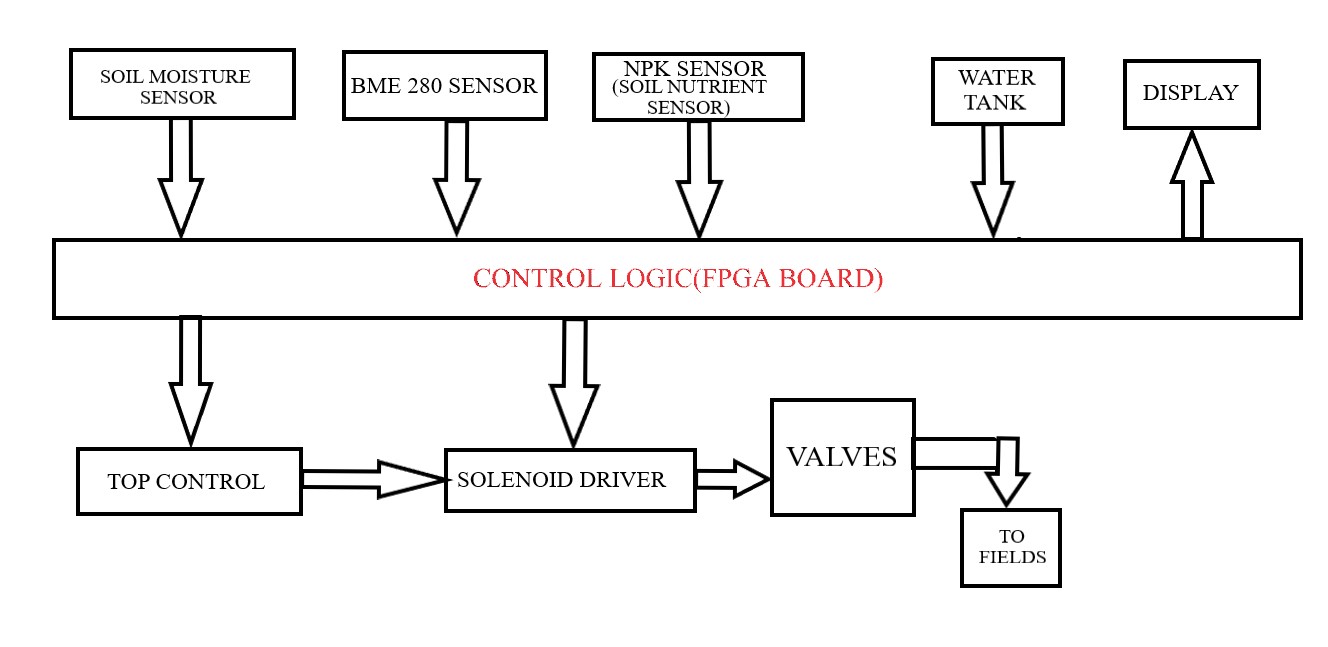Prediction of nature is uncertain. This uncertainty creates an imbalance in many things just like no proper rainfall in many areas. it’s important to generate crops with the required moisture. Due to differences in areas, the rate of moisture and fertility of the soil is different in different soils. To meet the requirements of moisture, we design a device that measures moisture at the bottom of the plants with the help of moisture sensors such that we can provide the necessary amount of water using valves. For soil fertility, different minerals in different compositions are required for different crops. our design also helps in detecting and measuring nitrogen, phosphorus, and potassium using NPK sensors. By adding BME 280 sensor, we can provide additional information like pressure, temperature, and humidity. This may help farmers in saving energy and time. the proposed system is designed using Verilog and implemented on FPGA. This system might create revolutionary of being handy to the farmers.
Project Proposal
1. High-level project introduction and performance expectation
This plant-based FPGA is the FPGA that is mainly designed to serve the purpose to avoid manual hard work.
Everybody knows that farmer has to put some efforts in monitoring plant conditions but this FPGA system saves the physical effort that farmer puts in to understand the level of moisture at roots, mineral quantity and climatic conditions like temperature, humidity, and pressure.
This system detects the above-mentioned things using sensors and provides information to the farmers who later on get to decide how the data provided can be used to save the crop/plant.
The main function of this FPGA System is that it senses the moisture content present at the bottom of the plant and provides water using valves that are communicated through the control unit. The Control unit initiates this action of providing enough water to the plant by the water tank using valves.
Secondary, This FPGA also senses the mineral content using NPK sensors and details farmers about it by displaying. Sequentially, the farmer decides how much extra minerals needed to be provided using the information he had provided by the system.
This FPGA system also instructs farmers about the climatic conditions like pressure, temperature, and humidity that surround the plant, such that farmers could take any actions if required.
Sensors like NPK, BME280, moisture sensors are used as basic blocks in this design.
This sensors acts as core function unit along with the control unit.
PURPOSE OF THE DESIGN:
This project serves the purpose of fulfilling the difficulties faced by a farmer and it also helps gardeners in reduction of their time consumption.
It helps in the reduction of manpower because its duty is done by our design.
It makes farmers efficiently use their resources like water.
BME 280 sensor benefits by providing climatic conditions at regular intervals.
APPLICATION SCOPE:
Farming Fields- helps farmers in acknowledging many minute details of the crop.
Vertical and Terrace gardenings
Greenhouses
Parks
Pavement paths
TARGETED USERS:
Farmers
Gardeners
2. Block Diagram
BLOCK DIAGRAM:

3. Expected sustainability results, projected resource savings
As mentioned earlier, This project is used to measure the moisture content of the plant, and based on the requirement it pumps the required moisture content in the form of water using a water tank to the plant
This device senses the amount of minerals present in the soil at the roots of the plant and informs the quantity in numbers to the farmer using a display.
After measuring the quantity, a sufficient amount of minerals and water are supplied to the fields(might be simultaneous or separately).
PARAMETERS:
To nurture a plant, NPK should be in the ratio of 3:1:2.
Supplying an adequate amount of NITROGEN helps plants to grow while greater amounts may result in the failure of seed (seed germination).
PHOSPHORUS helps to produce more flowers and fruits.
POTASSIUM is used to process all nutrients more efficiently, thereby it helps in improving quality.
The output of SOIL MOISTURE SENSOR changes in the range of ADC value from 0 to 1023 which later gets converted into some value and is displayed.
TEMPERATURE: In winters, seasonal crops like oats, wheat, and barley require 32-41°F for proper growth.
the optimum temperature of these plants is 77-88°F while temperatures between 25-28°F may not support proper growth.
4. Design Introduction
5. Functional description and implementation
6. Performance metrics, performance to expectation
7. Sustainability results, resource savings achieved
8. Conclusion
0 Comments
Please login to post a comment.